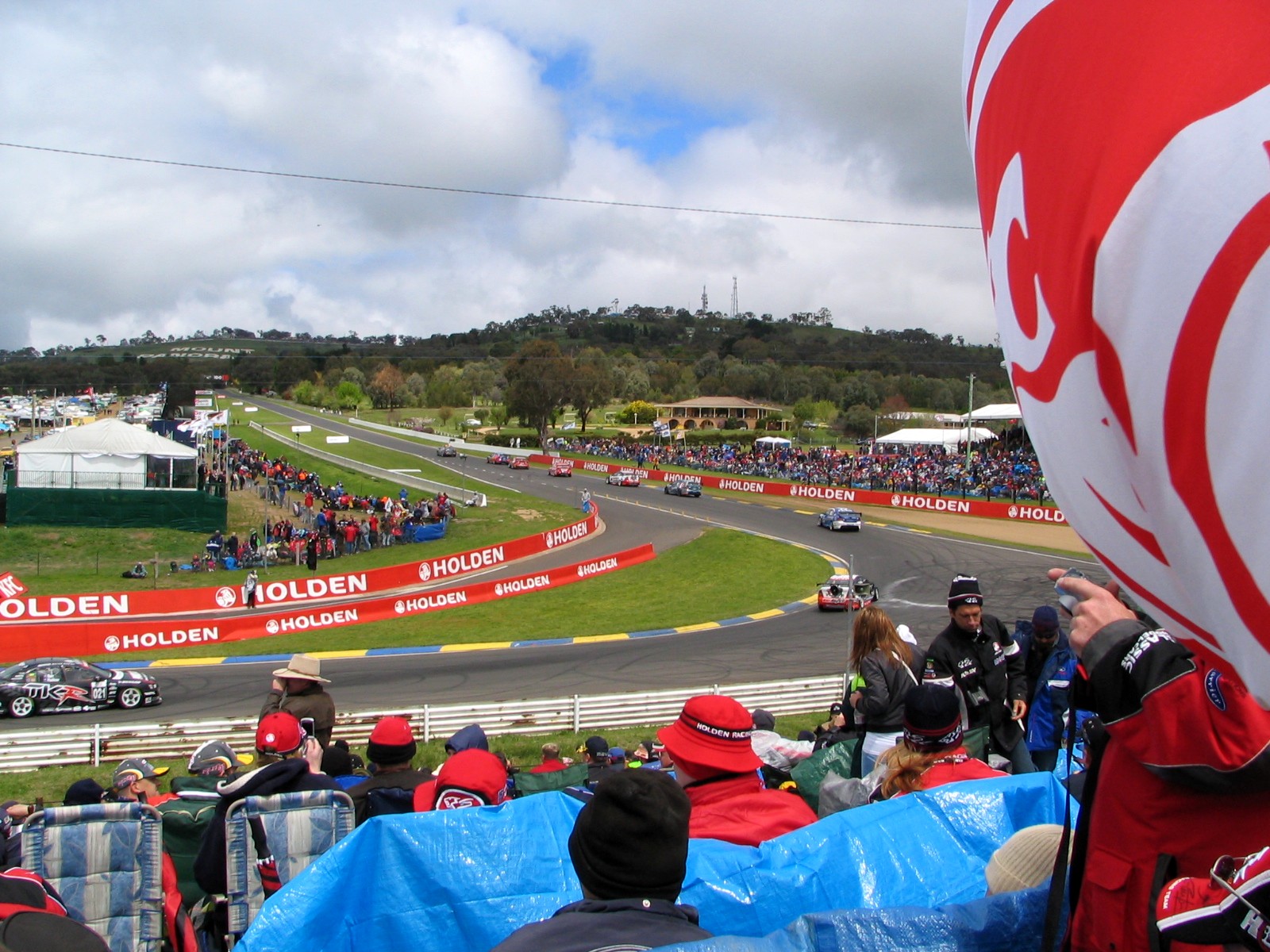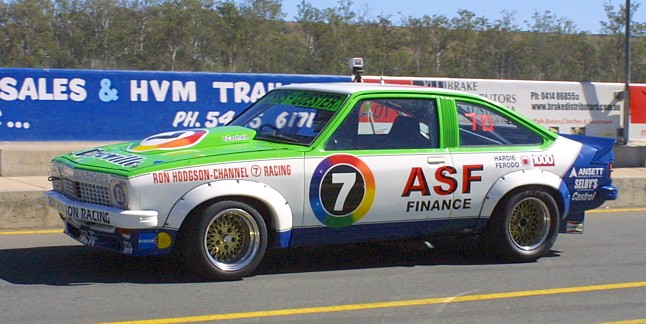|
Group E Series Production Touring Cars
Group E Series Production Touring Cars was an Australian motor racing category for production based sedans competing with limited modifications. It was current from 1964 to 1972. Although production car racing in Australia had gained momentum with the running of the first Armstrong 500 endurance race at Phillip Island in 1960, no national guidelines for this type of racing existed until 1 January 1964 when the Group E regulations were introduced by the Confederation of Australian Motor Sport as part of a major review of Australian motor sport categories. Vehicles racing in Group E had to be one of at least 1000 units which had been produced in 12 months and could compete only with strictly limited modifications. The rules were framed to cater for cars such as those that had been contesting the Armstrong 500 (which had moved from Phillip Island to the Mount Panorama Circuit at Bathurst in 1963), although that race continued to run under its own regulations which at the time limited ... [...More Info...] [...Related Items...] OR: [Wikipedia] [Google] [Baidu] |
Bathurst 1000
The Bathurst 1000 (known for sponsorship reasons as the Repco Bathurst 1000) is a Touring car racing, touring car race held annually on the Mount Panorama Circuit in Bathurst, New South Wales, Australia. It is currently run as part of the Supercars Championship, the most recent incarnation of the Australian Touring Car Championship. In 1987 Bathurst 1000, 1987 it was a round of the 1987 World Touring Car Championship, World Touring Car Championship. The Bathurst 1000 is colloquially known as ''The Great Race'' among motorsport fans and media. The race originated with the 1960 Armstrong 500 with a 500 mile race distance at the Phillip Island Grand Prix Circuit; it was relocated to Bathurst in 1963 also with the 500 mile distance and has continued there every year since, extending to a 1,000 kilometer race in 1973. The race was traditionally run on the New South Wales Labour Day#Australia, Labour-Day long weekend in early October. Since 2001, the race has been run on the weekend f ... [...More Info...] [...Related Items...] OR: [Wikipedia] [Google] [Baidu] |
Phillip Island Grand Prix Circuit
The Phillip Island Grand Prix Circuit is a motor racing circuit located near Ventnor, Victoria, Ventnor, on Phillip Island, Victoria (Australia), Victoria, Australia. The current circuit was first used in 1952. Along with The Bend Motorsport Park in South Australia, the long island circuit is one of two race tracks in Australia to carry a Fédération Internationale de Motocyclisme, FIM Category A track licence which allows for the highest level of motorcycle racing, MotoGP. Phillip Island also carries an Fédération Internationale de l'Automobile, FIA Grade 3 track licence. History Road circuit Motor racing on Phillip Island began in 1928 with the running of the 1928 100 Miles Road Race, 100 Miles Road Race, an event which has since become known as the first Australian Grand Prix. It utilised a high speed rectangle of local closed-off public roads with four similar right hand corners. The course length varied, with the car course approximately per lap, compared to the ... [...More Info...] [...Related Items...] OR: [Wikipedia] [Google] [Baidu] |
Confederation Of Australian Motor Sport
Motorsport Australia, formerly the Confederation of Australian Motor Sport (CAMS), is the nationally recognised governing and sanctioning body for four-wheeled motorsport Motorsport or motor sport are sporting events, competitions and related activities that primarily involve the use of Car, automobiles, motorcycles, motorboats and Aircraft, powered aircraft. For each of these vehicle types, the more specific term ... in Australia. It is affiliated with the Federation Internationale de l'Automobile (FIA). Responsibilities Motorsport Australia has been the custodian of motor sport in Australia since 1953. It is the National Sporting Authority (ASN) for motorsport in Australia, recognised by Sport Australia, and is delegated this responsibility by the FIA. Motorsport Australia affiliated with the FIA in its own right in 1958 before being granted full membership in October of that year on a probationary basis. In 1960, Motorsport Australia's membership of the FIA as an ASN was ... [...More Info...] [...Related Items...] OR: [Wikipedia] [Google] [Baidu] |
Mount Panorama Circuit
Mount Panorama Circuit, officially Mount Panorama/Wahluu via dual naming, is a motor racing track located in Bathurst, New South Wales, Australia. It is situated on Mount Panorama and is best known as the home of the Bathurst 1000 motor race held each October, and the Bathurst 12 Hour event held each February. The track is a long street circuit, which is used as a public road when no racing events are being run, with many residences which can only be accessed from the circuit. The track has an unusual design by modern standards, with a vertical difference between its highest and lowest points, and grades as steep as 1:6.13. From the start-finish line, the track can be viewed in three sections; the short pit straight and then a tight left turn into the long, steep Mountain straight; the tight, narrow section across the top of the mountain itself; and then the long, downhill section of Conrod Straight, with the very fast Chase and the turn back onto the pit straight to complet ... [...More Info...] [...Related Items...] OR: [Wikipedia] [Google] [Baidu] |
Australian Touring Car Championship
The Australian Touring Car Championship (ATCC) is a touring car racing award held in Australia since 1960. The series itself is no longer contested, but the title lives on, with the winner of the Repco Supercars Championship awarded the trophy and title of Australian Touring Car Champion. History The first Australian Touring Car Championship was held in 1960 as a single race for Appendix J Touring Cars. This was reflected the rising popularity of races held for passenger sedans; as opposed to those for purpose built open wheel racing cars, or sports cars. The race was held at the Gnoo Blas Motor Racing Circuit in Orange in rural New South Wales, west of Sydney. It was won by journalist racer, David McKay driving a Jaguar 3.4 Litre prepared by his own racing team, which to this point had been better known for preparing open-wheel and sports racing cars. The early years of the ATCC saw the annual event held mostly at rural circuits, before finally visiting a major city ... [...More Info...] [...Related Items...] OR: [Wikipedia] [Google] [Baidu] |
Group C (Australia)
In relation to Australian motorsport, Group C refers to either of two sets of regulations devised by the Confederation of Australian Motor Sport (CAMS) for use in Australian Touring Car Racing from 1965 to 1984. These are not to be confused with the FIA's Group C sports car regulations, used from 1982 to 1992 for the World Endurance Championship / World Sports-Prototype Championship / World Sportscar Championship and the 24 Hours of Le Mans. History Group C Improved Production Touring Cars Group C Improved Production Touring Car regulations were introduced by CAMS in 1965 to replace the Appendix J rules which had been in force since 1960. The Australian Touring Car Championship was run to these new rules from 1965 to 1972, initially as a single race championship and from 1969 as a multi round series. Group E regulations defining rules for Series Production Touring Car racing in Australia had previously been introduced with effect from 1 January 1964. The leading cars of the ... [...More Info...] [...Related Items...] OR: [Wikipedia] [Google] [Baidu] |
Australian Manufacturers' Championship
The Australian Manufacturers' Championship was a motor racing title awarded by the Confederation of Australian Motor Sport (CAMS) to the winning car manufacturer in an annual series of races held throughout Australia. Whilst the first two championships were open only to Group E Series Production Touring Cars subsequent championships through to 1991 were run to the same regulations as the Australian Touring Car Championship. The title has been revived twice since then, firstly in 1994 as a championship open to 2-litre Class II Touring Cars (soon to become known as Super Touring Cars) and from 2008 as a series for production cars, incorporating the Australian Production Car Championship The Australian Production Car Championship is an Australian motor racing title for production car racing, production cars. The championship was first contested in 1987 and from 2008 to 2015 the title was awarded to the most successful driver in th .... For 2016 the Australian Manufacturers' Cham ... [...More Info...] [...Related Items...] OR: [Wikipedia] [Google] [Baidu] |
Supercar Scare
The Supercar scare was a national controversy that arose in Australia in 1972 in regard to the sale to the public of high performance "homologation special" versions of Australian-built passenger cars. The reason Despite the popular belief of the performance motoring public of the time that focuses solely on Evan Green's 25 July 1972 headline article on proposed Australian "supercars", in fact the controversy had started many years as early as 1967, as Evan Green's article was released and printed barely a week before the very last and final announcements were made by the relevant companies and authorities that ended all supercar programs. Public complaints and government minister concerns had originally started before the Ford XR GT was even officially released in 1967, as reported by various mainstream Australian newspapers of the time. A good example would be the concerns noted by Clyde Hodgins in a 26 March 1967 article for ''The Sydney Morning Herald'', proclaiming a 115& ... [...More Info...] [...Related Items...] OR: [Wikipedia] [Google] [Baidu] |
Group E Series Production Cars
Group 3E Series Production Cars is an Australian motor racing formula for production based cars competing with limited modifications. Group 3E cars formerly contested the Australian Manufacturers' Championship and Australian Production Car Championship titles and compete in the annual Bathurst 12 Hour and Bathurst 6 Hour endurance races. History Regulations for production car racing in Australia were first formalised in 1964 when the Confederation of Australian Motor Sport introduced the Group E Series Production Touring Cars category. This was abandoned at the end of 1972. “Series Production” made a return to Australian motor racing in 1981 when a new set of Group E regulations was issues by CAMS. The new Series Production Cars were, like their predecessors, intended to be mass-produced vehicles made suitable for competition by minimal modifications. Eligible cars were limited to those with an engine capacity of less than 4500cc and only vehicles which CAMS specifically chose ... [...More Info...] [...Related Items...] OR: [Wikipedia] [Google] [Baidu] |



